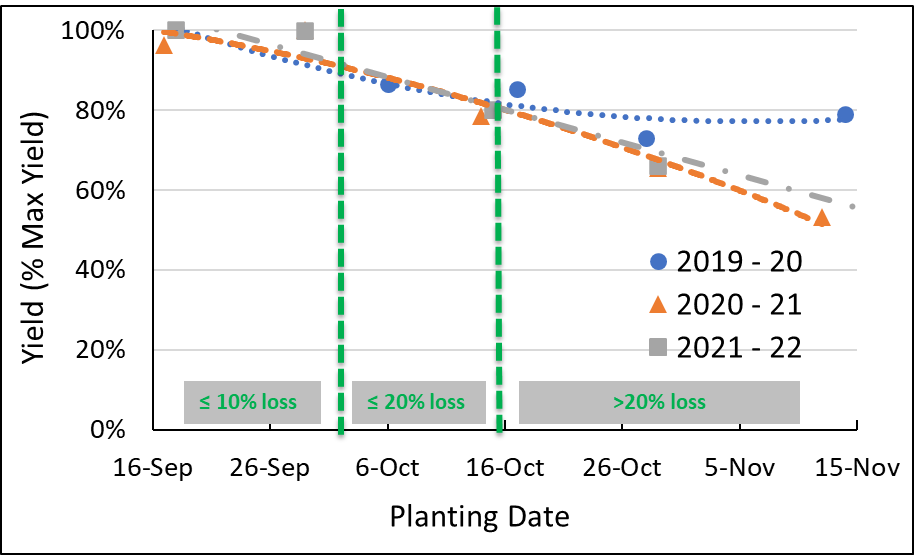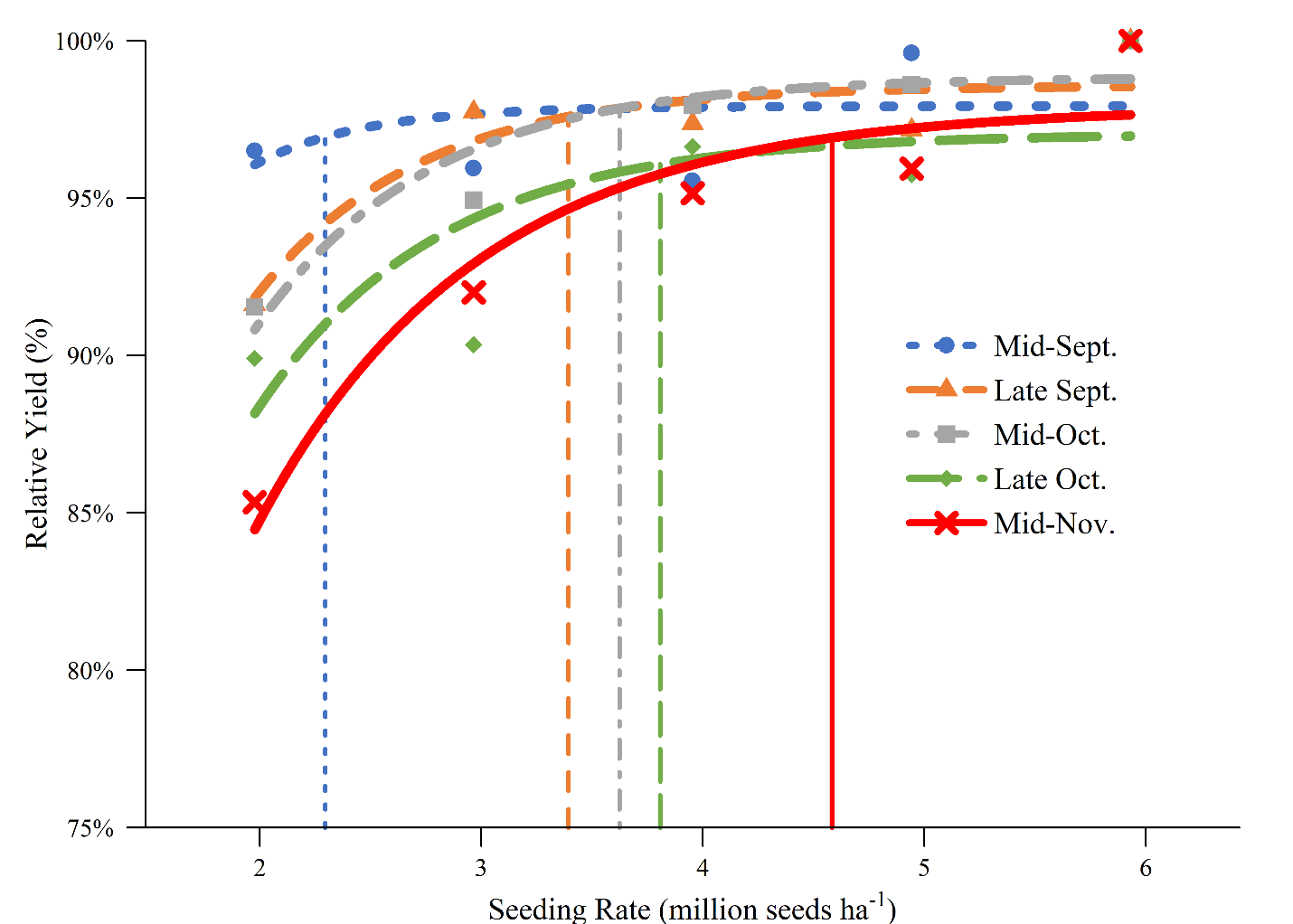Management considerations for late-planted wheat
Planting wheat in late October or early November? Make sure to follow these tips.

In a perfect world, wheat should be planted soon after the Hessian fly-free date. Highest yields are often attained when seedlings emerge within two weeks following the posted fly-free-date, assuming heat unit accumulation is near average in October and November. The goal is to plant early enough to produce two to three tillers before the winter vernalization period.
That being said, planting early isn’t always possible. The combination of drought in June plus below normal heat unit accumulation this growing season has many growers concerned about when soybean and dry bean harvest will start and how that delay will affect winter wheat planting. Some are considering alternatives such as aerial seeding wheat.
Planting date
Research at Michigan State University on planting dates shows losses in yield potential for late planted wheat, but it is variable from year to year. Data from a planting date study funded by the Michigan Wheat Program and Michigan Crop Improvement Association and conducted at the MSU Mason Research Farm in 2019-20, 2020-21 and 2021-22 growing seasons is presented in Table 1 and Figure 1. Wheat was planted on five dates starting in mid-September and continuing about every two weeks until mid-November. In these trials, maximum yield was observed with September plantings. Planting in mid-October resulted in 14-20% yield decline across the three years of research. However, yield decline after mid-October was dependent on year (weather conditions in late fall and winter). Decline in yield beyond mid-October planting ranged from 33-46% over the last two seasons (2020-21 and 2021-22) and 21-27% in the 2019-20 season. Overall, yield decline after mid-October was greater than 20% in all trials (Figure 1).
|
Table 1. Decline in winter wheat yield beyond mid-September over the last three growing seasons from trials planted at Mason, Michigan. |
|||
|---|---|---|---|
|
Plant date |
% Decline (after mid-September) |
||
|
2019-20 |
2020-21 |
2021-22 |
|
|
Mid-September |
-- |
-- |
-- |
|
End-September |
14 |
-- |
-- |
|
Mid-October |
15 |
20 |
20 |
|
End-October |
27 |
33 |
34 |
|
Mid-November |
21 |
46 |
44 |

Seeding rate and depth
The recommended seeding rate for wheat is to plant between 1.0 and 1.8 million seeds per acre. If you are planting within a week of the Hessian fly-free date, you should use seeding rates on the lower end of the range to avoid overly thick stands that can promote disease development and increase the likelihood of lodging the following season.
As the calendar advances, seeding rates should become progressively higher. If planting continues into the third week of October or later, you should increase your seeding rates to at least 1.6 million seeds per acre (23 or more seeds per foot of row). Also, planting shallower (around 1 inch or less) will allow the seedlings to emerge more quickly and start tillering. If planting in early November, these seedlings may not emerge until next spring.
Figure 2 shows the percent of relative yield for five planting dates and five seeding rates from 2019-20 to 2022-23. The top of the chart represents 100% of the maximum yield achieved for each planting date. Notice that earlier planting dates achieved higher percent relative yield at lower seeding rates. Later planting dates required higher seeding rates to achieve higher yields. This trial was conducted on a sandy loam soil type using conventional tillage with a drill on 7.5-inch row spacing. The Agronomically Optimum Seeding Rate (AOSR) was calculated for each planting date:
- Mid-September = 0.93 million seeds per acre
- Late-September = 1.37 million seeds per acre
- Mid-October = 1.47 million seeds per acre
- Late-October = 1.54 million seeds per acre
- Mid-November = 1.85 million seeds per acre

Planting method
There has recently been increased interest in broadcast incorporation of wheat seed. An air seeder mounted on a high-speed tillage tool has been the preferred method. This allows for faster planting and more acres planted per day. A study funded by the Michigan Wheat Program and Project GREEEN was initiated in 2020-21 crop to evaluate broadcast incorporation against other planting methods. Data from three years of the study suggests that broadcast incorporation can produce yields comparable to drilled wheat (Figure 3) including under delayed planting conditions. Air distributed metering systems provide a more uniform spread pattern compared to most spinner/spreaders. More information about the planting methods study, including precision wheat planting, can be found at “Alternative planting strategies for maximizing yield potential in winter wheat” from Michigan State University Extension.
There has also been recent interest in aerial seeding wheat into standing bean crops. The goal is to get wheat planted earlier. This method relies on leaf drop to cover the wheat seed and provide an environment for the seeds to germinate and emerge. Data from University of Wisconsin-Madison, Ontario Ministry of Agriculture, Food and Rural Affairs and the University of Saskatchewan show that at best, this works in about three out of four years. Timing is critical—you must get seed flown on prior to 50% leaf drop. Some additional risks include treated seed landing on bean plants that get harvested and make their way into the combine during harvest. Treated wheat seed in a load of beans will be rejected at the elevator. Moreover, crown roots of wheat would be located closer to the soil surface rather than at least one-half inch below the surface. This could lead to increased heaving, winterkill and lodging next summer. Access to aerial applicators can be a challenge as there are a limited number of companies that provide this service. You should weigh the potential gain by planting early with all of the risks associated with aerial seeding. You should also compare the cost of aerial seeding compared to drilling or broadcast incorporation of wheat later.
Oct. 25 is the planting deadline for crop insurance, so the later it gets the more risk the grower must assume.

Other considerations
As the fall progresses, late-planted wheat seeds might be slower to emerge due to lower temperatures. In order to protect the vulnerable seed from soil-borne diseases, fungicide seed treatments should be considered.
If you plan to plant wheat in late October or even early November, make sure to apply approximately 20 pounds per acre of nitrogen fertilizer this fall, hoping that an extended fall season may allow some tiller development. To further promote tillering, apply some or all of next spring’s nitrogen early during green-up.
Wheat is responsive to phosphorus, so starter fertilizer should contain the appropriate amount of phosphorus based on soil test levels. Some have questioned if adding phosphorus fertilizer would be more important when planting late compared to early planting. MSU research shows that you do benefit from starter phosphorus when planting late. However, you get more benefit from starter phosphorus when planting early compared to late planting.



 Print
Print Email
Email